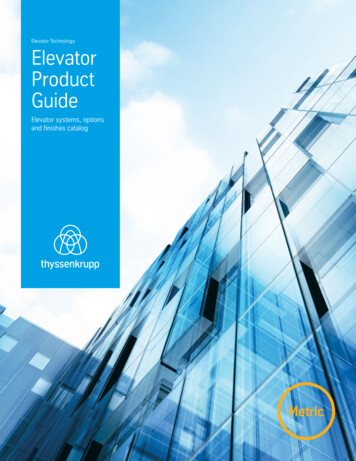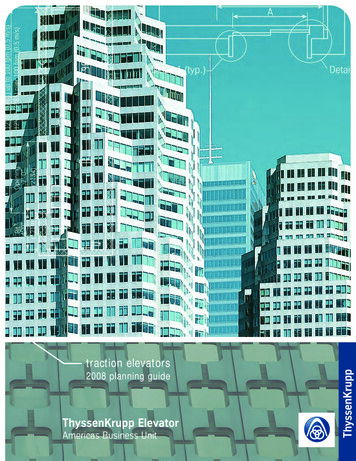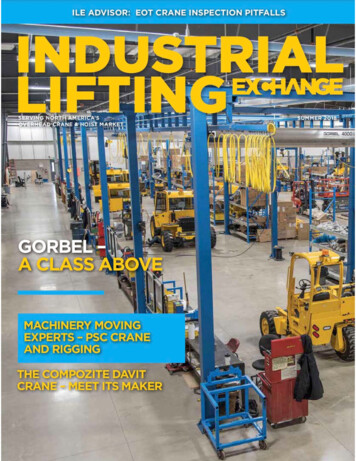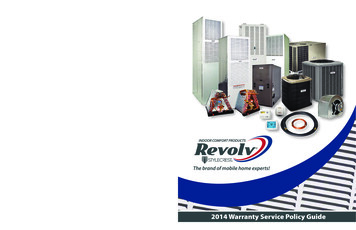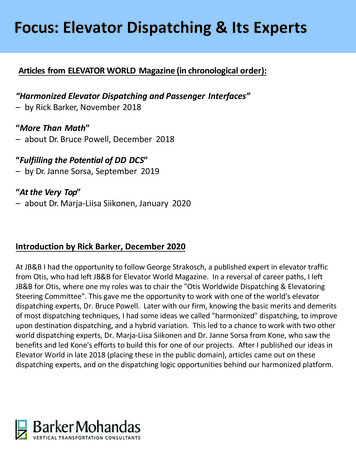
Transcription
Focus: Elevator Dispatching & Its ExpertsArticles from ELEVATOR WORLD Magazine (in chronological order):“Harmonized Elevator Dispatching and Passenger Interfaces”– by Rick Barker, November 2018“More Than Math”– about Dr. Bruce Powell, December 2018“Fulfilling the Potential of DD DCS”– by Dr. Janne Sorsa, September 2019“At the Very Top”– about Dr. Marja‐Liisa Siikonen, January 2020Introduction by Rick Barker, December 2020At JB&B I had the opportunity to follow George Strakosch, a published expert in elevator trafficfrom Otis, who had left JB&B for Elevator World Magazine. In a reversal of career paths, I leftJB&B for Otis, where one my roles was to chair the "Otis Worldwide Dispatching & ElevatoringSteering Committee". This gave me the opportunity to work with one of the world's elevatordispatching experts, Dr. Bruce Powell. Later with our firm, knowing the basic merits and demeritsof most dispatching techniques, I had some ideas we called "harmonized" dispatching, to improveupon destination dispatching, and a hybrid variation. This led to a chance to work with two otherworld dispatching experts, Dr. Marja-Liisa Siikonen and Dr. Janne Sorsa from Kone, who saw thebenefits and led Kone's efforts to build this for one of our projects. After I published our ideas inElevator World in late 2018 (placing these in the public domain), articles came out on thesedispatching experts, and on the dispatching logic opportunities behind our harmonized platform.
Focus: Elevator/Lift Dispatching & PeopleELEVATOR WORLD Magazine, November 2018“Harmonized Dispatching and Passenger Interfaces”– by Rick Barker5
TechnologyImprovements in trafficperformance and user interfacesare shown in a case study on PNB118, a 118-story building underconstruction in Kuala Lumpur.by Rick BarkerIntroduction and CreditsThis article is based on an unpublished paper, “Intent ofSpecifications for Harmonized Dispatching — Groups of PassengerElevators/Lifts for Office Buildings” by Barker Mohandas, LLC, andour prior project specifications covering such designs. Our designsas covered herein are now published for use without anyrestrictions from us. All designs by others that are referenced retaintheir exclusive rights.This is also a case study on the designs as they are being builtnow by KONE under our specifications for the PNB 118 project inKuala Lumpur. Some of our initial fixture sketches are shown, alongwith some in-progress project graphics by KONE. A keycontributor to this article has been KONE’s Dr. Janne Sorsa, whohas also provided updated and expanded simulations initiallyprovided by Dr. Marja-Liisa Siikonen. They have both beeninstrumental in taking the designs for the project forward.It is also essential to recognize the foundational work of Dr. JorisSchröder and Dr. Paul Friedli in Schindler’s Miconic 10 (M10)system, introduced in the early 1990s. This was the firstcommercially successful destination-dispatching system and,perhaps, the first major visible change in the automatic elevator. Anexcellent reference on “M10” is the article by Joris Schröder in theMarch 1990 edition of ELEVATOR WORLD.[1]We have retained the Schindler techniques functionally at themain lobby for their benefits in handling and organizing incomingtraffic and added some user improvements at that location (while82www.elevatorworld.com November 2018we recognize that these improvements have likely already beenbuilt somewhere). However, in the cabs and at the office floors,things are different, yet also familiar in restoring and enhancingconventional elements in ways we believe improve known priorsuch techniques for office buildings.Our goal was to bring predeveloped elements together in a waymultiple elevator companies could build the designs, using acombination of dispatching techniques they had already developedunderneath, overlayed with today’s touchscreen displays andemploying some contract engineering. The word “harmonized”then came to mind. Our motivation was to improve lunchtimetraffic performance for double-deck elevators (primarily) andsingle-deck elevators (secondarily), and improve passengerinterfaces for both.This is not a detailed work on elevator dispatching or its smartalgorithms, which decide which elevators in a group are to servewhich calls. Statements made about the development of the logicare to the best of your author’s knowledge. Experts in the field willlikely know of various recent studies, including a major body ofwork by Janne Sorsa.[2] A small part of that work pertaining todouble-deck elevators was partially inspired by our project designs.Special credit is also extended to Dewhurst PLC, an independentU.K. provider of fixtures to the elevator/lift, keypad and railindustries, for its details of keypad buttons, arrows and car lettersigns used in our original sketches. Also, the project graphics arein-progress screenshots by KONE that show industrial designthought extending beyond our sketches, which were only functionaldrawings.Present Categories of Dispatching and PassengerInterfaces for Office BuildingsWhen developing the designs, we saw three general categories ofdispatching and passenger interfaces for office buildings, including ahybrid version of the other two. At the risk of boring many readers(especially elevator-industry professionals), these are described asfollows.Conventional Dispatching and Passenger InterfacesMost people are familiar with groups of elevators that useconventional up/down buttons at all floors, individual floor buttonsin the cabs and an up/down hall arrival lantern at all entrances. Ofcourse, at the terminal floors, such as the main lobby in an office
building, there is a single “up” or “down” button and hall lanternsignal. We generally categorize such systems as “conventional.” (Itshould be noted that this term does not imply that today’sdispatching is old fashioned, given its smart algorithms behind thescenes.)Passengers press the up or down button at any floor for theirdirection (unless it is already pressed) as acknowledged by thefamiliar “call-registered” light. They then wait for an elevator toarrive as signaled by a hall lantern at the respective entrance, givingthem enough notice to walk to the doors. As an aside, under U.S.building codes and standards, the traffic performance ofconventional dispatching can be penalized by requirements forpersons with disabilities. Without special operation, that for somereason is only allowed with destination dispatching under ICCA117.1-2017 Accessible and Usable Buildings and Facilities, the doordwell open time for all hall calls at all floors, including from allnondisabled persons, is to be based on a formula for the time for adisabled person to travel from the farthest hall station. This is adetailed benefit of destination dispatching and our harmonizeddesigns.After boarding the cab, thepassengers press another button fortheir specific floor. For double-deckelevators with conventionaldispatching, when the elevator is atits double-level main lobby, only theeven-numbered floor buttons in thecab will be functional in the lowerdeck, and only the odd-numberedbuttons will be functional in theupper deck (or vice versa, dependingon building floor numbering).However, all in-cab buttons arealways visible.There is often a delay in the halllantern signaling which elevator isultimately assigned to the call. Thisallows the dispatching logic moretime to optimize the final carassignment behind the scenes,considering many variables on trafficdemands and the status of allelevators in the group, whichcontinually change. This is a keypoint in this article.To better understand thedispatching challenge of whichelevator to assign to which hall call,consider a group of six single-deckelevators with eight hall calls. At thatmoment (and assuming conventionaldispatching with delayed carassignments), there are about 68, or1.7 million, possible car-to-callassignments. This is quite acombinatorial problem. Based onrecent communications between your author and Dr. BrucePowell, who is well known as a top elevator-dispatching expert, henoted that, in one sense, destination dispatching (where carassignments are made instantly at all floors) simplifies the problemby reducing such choices to six, while smart algorithms can make anearly impossible optimization problem (such as 68) a task ofmanageable proportions (for conventional dispatching). Of course,smart algorithms are also used in standard destination-dispatchingproducts to try to make the first and “instant” car assignment agood decision. Elevator dispatching experts, using the informationavailable, can turn the problem into opportunities to reducewaiting times.Destination Dispatching and Passenger InterfacesMany people are now also familiar with destination dispatchingfound in newer office buildings, as reflected in Figures 1 and 2(and, possibly, Figure 3 if the building has double-deck elevators).There are no floor buttons in the cabs accessible to passengers, andthere are no signals at the elevator entrances — only static signs asto the car’s designation (car A, B, C, etc.). Again, the March 1990EW article[1] is an excellent reference.ContinuedNovember 2018 ELEVATOR WORLD83
Figure 1: Keypad call stations at all floors (left), car designation sign atentrances (top right) and display inside the cabs (bottom right): similarsystems are available from Otis; KONE; Mitsubishi Electric; thyssenkrupp;and, of course, Schindler, which introduced the technique. Graphic is froma KONE presentation on passenger interfaces for destination dispatching.Figure 3: Boarding double-deck elevators by odd- versus evennumbered floors has become the standard circulation plan. This wasdeveloped by Otis along with the double-deck elevator. Graphic isfrom a Schindler presentation on boarding double-deck lifts at adouble-level main lobby. Note the keypad call stations at both levelsof the main lobby. Also, as a planning reference for the first moderndouble-deck systems, see “Planning Double Deck Elevator Systems” byW.H. Wuhrman and Paliath Mohandas.[4]Car assignments are given “instantly” to each person at all floors(including at all office floors), typically at numeric keypad-type callstations in the elevator lobbies, where all passengers enter theirdestinations. After a person enters their destination, the carassigned to the call is displayed “instantly” at the station and onlymomentarily to allow for another person to place their call. Eachperson must (or should) enter their destination call this way. Anexception is a group of people traveling to the same floor, such asthe main lobby. No call acknowledgement or status signal isprovided to the user after the car assignment is made. At the officefloors, users wait at the entrance of the car assigned for as long as ittakes for that specific elevator to arrive.After a meeting when a group of passengers returning todifferent office floors arrives in an elevator lobby, where anelevator’s doors are already open for a car headed in theirdirection, they cannot simply board the cab. Again, there are nofloor buttons in the cab. Also, a passenger cannot change their floordestination in flight if their call was entered in error.84www.elevatorworld.com November 2018Figure 2: This graphic is from a Schindler brochure depicting howMiconic 10 helps organize queues at the main lobby. This can also havebenefits in elevator lobby planning. Note that 24 people are shown inboth cases. However, in principle, the up-peak traffic performance canreduce the total queue of passengers in the main lobby.The primary traffic benefit tends to be at the main lobby, toimprove handling capacity for incoming traffic. Note that theimprovement in up-peak traffic performance at the main lobby canbe significant with single-deck and very significant with doubledeck elevators, which stop at two floors at a time when leaving themain lobby to handle incoming traffic. However, theseimprovements should not be used to reduce elevators, as standarddestination dispatching can increase waiting times during thelunchtime peak. (An exception is using the dispatching for a groupof shuttle elevators serving multiple residential sky lobbies in asupertall building as covered in “Sequel: Is 4,000 fpm (20 mps)Enough?” by your author with contributions from Sean Morris andGeorge Wisner.[3] )In knowing passengers’ destinations at the main lobby, cars canbe assigned to groups of people by some commonality in theirdestinations, such as by floor zones or sectors, to reduce elevatorstops and travel and, therefore, car round-trip time back to themain lobby. Note that techniques such as Otis Channeling (invented by Joseph Bittar and Kandasamy Thangavelu) usingdynamic sectoring or zoning also boosted up-peak performance atthe main lobby. Individual floor buttons in a lobby actually date tothe 1960s with the work of Leo Weiser Port in Australia. However,Schindler Miconic 10 was the first successful destinationdispatching system that also organized traffic queues at the mainlobby, while boosting up-peak performance. There have beenmany patents since using floor destinations entered in an elevatorlobby, even including a few Otis patents by your author (FrederickBarker) with coinventors such as Bittar and Powell.A related benefit is that passenger queues are organized at themain lobby, where traffic is the heaviest. People tend to gathercloser to the entrances of the cars assigned to them, which is abenefit for circulation planning. There are also some detailedbenefits of destination dispatching: The call system can be integrated with identification cards usedat security turnstiles at the main lobby. This can have circulation
benefits in reducing cross-traffic, along with some dispatchingbenefits. Keypad-type call stations can easily allow passcodes for specialfeatures for staff, etc. Entering a floor destination in the lobby also easily allows anelevator to be assigned to a floor ser
Schröder and Dr. Paul Friedli in Schindler’s Miconic 10 (M10) system, introduced in the early 1990s. This was the first commercially successful destination-dispatching system and, perhaps, the first major visible change in the automatic elevator. An excellent reference on “M10” is the article by Joris Schröder in the March 1990 edition of ELEVATOR WORLD.[1] We have retained the .
